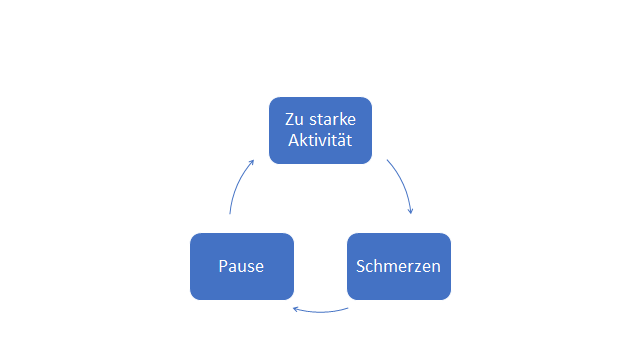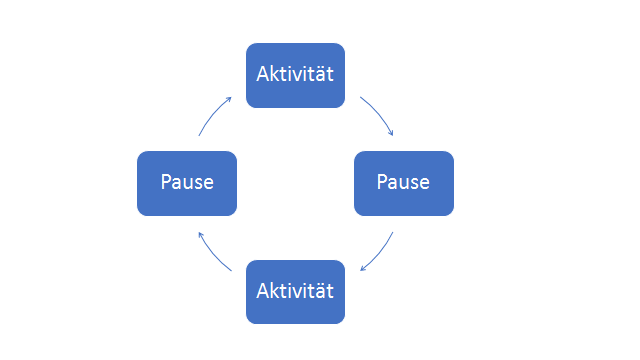Finding Balance Amidst Pain
Nothing gets us on our way better than a break – Elizabeth Barrett Browning
Achieving peak performances at work or in sports is a common aspiration. However, individuals dealing with frequent pain face a unique set of challenges. A detrimental cycle can often ensnare those who experience pain regularly, exacerbating pain and fatigue over time. To illustrate this, let us explore three fictional scenarios [3]:
- Lisa (23): Too Little Activity – Meet Lisa, a 23-year-old student who resides with her parents. She lives in constant fear of pain and is cautious not to exacerbate her condition. Consequently, she rests most of the time and refrains from engaging in activities that might worsen her pain. Sadly, she has noticed that her pain intensifies every time she attempts something. As a result, Lisa progressively withdraws from activities, gives up on sports, and isolates herself from her circle of friends. Similarly anxious and cautious, her parents have taken over many aspects of her daily life. This relentless cycle leaves Lisa exhausted and incapable of performing even the simplest tasks.
- Julia (44): Too Much Activity – Next is Julia, a 44-year-old with a demanding life juggling family responsibilities and a full-time job. Despite enduring severe pain, Julia relentlessly pushes herself to work without breaks, consistently placing others’ needs ahead of hers. She strives to meet high standards and is burdened by guilt when she falls short. Unfortunately, those around her fail to grasp the seriousness of her condition, offering dismissive comments such as “You are not sick; just tough it out.” Over time, Julia has ignored the pain, landing her in the hospital twice when the pain became unbearable, leaving her immobile.
- Marie (38): Alternating Between Extremes – We have Marie, a 38-year-old independent artist whose life oscillates between good and debilitating days. On good days, she awakens without pain, plunges into 10-hour work marathons, follows up with a strenuous hour-long jog, and tends to her household chores in the evening. Once she starts a task, she is determined to see it through, dismissing signs of increasing fatigue. However, the following day often brings excruciating pain, prompting Marie to rely on painkillers and spend most of her day resting. She can barely manage a short walk. Gradually, she notices a troubling pattern: bad days become more frequent, and good days grow increasingly scarce. Frustration mounts, leading her to attempt even more on the rare good days to compensate for the worsening bad days.
As evident in the provided examples, activity pacing represents a crucial objective for individuals managing pain, albeit one that can be challenging to attain. In instances of acute pain, rest may be often imperative. However, when dealing with chronic pain, remaining active becomes equally essential. It is worth noting that the documented benefits of physical activity and exercise on various forms of pain are now well-established [4].
How Do I Find a Balance Between Activity and Rest?
As demonstrated by the examples, it is clear that neither entirely disregarding severe complaints (as seen in Julia’s case) nor allowing them to hinder all activity (as exemplified by Lisa) is a helpful approach. A more effective strategy involves breaking activities into manageable intermediate steps and incorporating planned breaks between them. Furthermore, engaging in activities gradually rather than in prolonged, intense bursts is crucial. Efficiently allocating energy and planning your day for long-term achievement is essential [8]. Equally important is setting priorities to ensure you do not expend precious energy on unimportant tasks during challenging days. Figure 1 illustrates the vicious circle experienced by Marie in example 3.

Figure 1: Pain cycle
In Figure 2, we present an alternative approach characterized by shorter bouts of activity interspersed with consistent rest periods. This approach offers tailored solutions for individuals like Julia, who may need to incorporate more breaks into her routine. Similarly, Lisa can aim to engage more actively in life through gradual, incremental steps. As for Marie, it is essential not to overextend herself on good days to ensure she can manage more during challenging ones. Achieving the ideal balance between activity and rest is, ideally, a highly personalized endeavor [7].

Figure 2: Change between activity and rest
Regrettably, no study has explicitly delved into the pain-related vicious cycle prevalent in endometriosis. Nonetheless, there exist studies on its impact in a broader context. In one study encompassing 68 individuals with chronic pain, a significant correlation emerged between pain levels and the extremes of activity, whether excessive or insufficient. Excessive exercise and avoidance of it were linked to heightened pain perception. Intriguingly, excessive activity yielded equally mixed results, manifesting in very good and very bad days, mirroring the experience of someone like Marie [1]. The pernicious cycle of fluctuating activity levels, swinging between too much and too little, can also contribute to depressive symptoms and constraints on daily functioning [6]. Additionally, it has been associated with increased consumption of pain medications [2]. In contrast, maintaining a healthy equilibrium between activity and rest is connected to enhanced psychological well-being [5]. You have likely experienced firsthand that progress often accrues more effectively through gradual, incremental steps rather than grand, exhaustive endeavors.
Exercise
- List activities where you overexert yourself and push beyond your limits. Identify essential and beneficial activities in a separate list, even during challenging days.
- Set predefined time limits for each activity. Implement planned breaks to ensure balance and recovery.
- Maintain a consistent record of your daily activities, breaks, emotional state, and overall progress.
The art of resting is part of the art of working – John Steinbeck
References
- Current Research on Endometriosis: An Interview with Louis Taffs - 28. June 2024
- Current Research on Endometriosis: An Interview with Dr. Tatjana Gibbons - 13. February 2024
- Current Research on Endometriosis: An Interview with Luana De Giorgio - 12. February 2024


